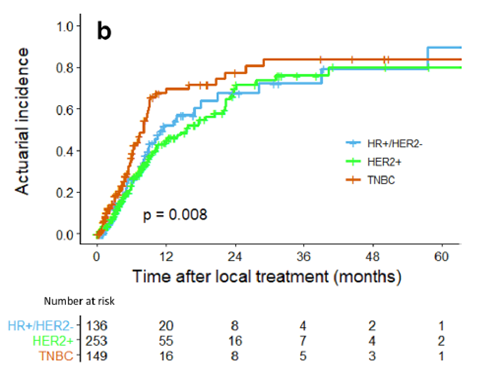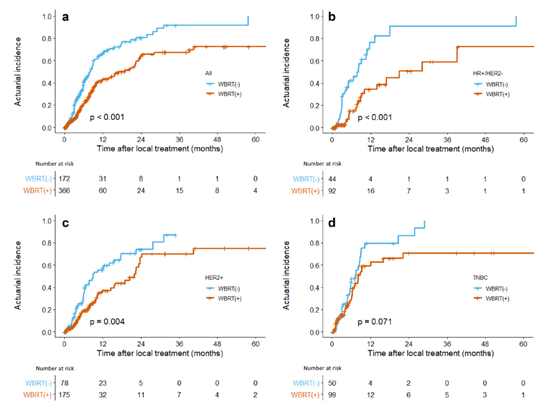글로벌 연구동향
방사선종양학
- [Breast Cancer Res Treat.] New brain metastases after whole-brain radiotherapy of initial brain metastases in breast cancer patients: the significance of molecular subtypes (KROG 16-12)
서울의대 / 김재식, 김규보, 김인아*
- 출처
- Breast Cancer Res Treat.
- 등재일
- 2021 Apr
- 저널이슈번호
- 186(2):453-462. doi: 10.1007/s10549-020-06043-0.
- 내용
Abstract
Purpose: To identify the risk factors leading to new brain metastases (BM) following brain-directed treatment for initial BM resulting from breast cancer (BC).Methods: In this multi-institutional study, 538 BC patients with available follow-up imaging after brain-directed treatment for initial BM were analyzed. Tumor molecular subtypes were classified as follows: hormone receptor-positive/human epidermal growth factor receptor 2-negative (HR+/HER2-, n = 136), HER2-positive (HER2+, n = 253), or triple-negative BC (TNBC, n = 149).
Results: In 37.4% of patients, new BM emerged at a median of 10.5 months after brain-directed treatment for initial BM. The 1-year actuarial rate of new BM for HR+/HER2-, HER2+, and TNBC were 51.9%, 44.0%, and 69.6%, respectively (p = 0.008). Initial whole-brain radiotherapy (WBRT) reduced new BM rates (22.5% reduction at 1 year, p < 0.001) according to molecular subtype (HR+/HER2-, 42% reduction at 1 year, p < 0.001; HER2+, 18.5%, p = 0.004; TNBC, 16.9%, p = 0.071). Multivariate analysis revealed an increased risk of new BM for the following factors: shorter intervals between primary BC diagnoses and BM (p = 0.031); TNBC (relative to HR+/HER2-) (p = 0.016); presence of extracranial metastases (p = 0.019); number of BM (>4) (p < 0.001); and BM in both tentorial regions (p = 0.045). Anti-HER2 therapy in HER2+ patients (p = 0.013) and initial use of WBRT (p < 0.001) significantly lowered new BM development.
Conclusions: Tumor molecular subtypes were associated with both rates of new BM development and the effectiveness of initial WBRT. Anti-HER2 therapy in HER2+ patients significantly lowered new BM occurrence.

Fig 1. Tumor subtype에 따라 새로운 뇌전이 병변 (distant intracranial failure) 발생률의 차이를 보였습니다.

Fig 2. 전뇌방사선치료 (whole-brain radiotherapy)를 통해 새로운 뇌전이 병변 발생을 감소시켰으며, tumor subtype에 따라 감소율에 차이를 보였습니다.
Affiliations
Jae Sik Kim # 1 , Kyubo Kim # 2 , Wonguen Jung 2 , Kyung Hwan Shin 1 , Seock-Ah Im 3 , Hee-Jun Kim 4 , Yong Bae Kim 5 , Jee Suk Chang 5 , Jee Hyun Kim 3 , Doo Ho Choi 6 , Yeon Hee Park 7 , Dae Yong Kim 8 , Tae Hyun Kim 8 , Byung Ock Choi 9 , Sea-Won Lee 9 10 , Suzy Kim 11 , Jeanny Kwon 12 , Ki Mun Kang 13 , Woong-Ki Chung 14 , Kyung Su Kim 2 15 , Won Sup Yoon 16 , Jin Hee Kim 17 , Jihye Cha 18 , Yoon Kyeong Oh 19 , In Ah Kim 20 21
1 Department of Radiation Oncology, Seoul National University College of Medicine, Seoul, Republic of Korea.
2 Department of Radiation Oncology, Ewha Womans University College of Medicine, Seoul, Republic of Korea.
3 Department of Internal Medicine, Seoul National University College of Medicine, Seoul, Republic of Korea.
4 Department of Internal Medicine, Chung-Ang University College of Medicine, Seoul, Republic of Korea.
5 Department of Radiation Oncology, Yonsei Cancer Center, Yonsei University College of Medicine, Seoul, Republic of Korea.
6 Department of Radiation Oncology, Samsung Medical Center, Sungkyunkwan University School of Medicine, Seoul, Republic of Korea.
7 Department of Internal Medicine, Samsung Medical Center, Sungkyunkwan University School of Medicine, Seoul, Republic of Korea.
8 Proton Therapy Center, National Cancer Center, Goyang, Republic of Korea.
9 Department of Radiation Oncology, Seoul St. Mary's Hospital, The Catholic University of Korea, Seoul, Republic of Korea.
10 Department of Radiation Oncology, Eunpyeong St. Mary's Hospital, The Catholic University of Korea, Seoul, Republic of Korea.
11 Department of Radiation Oncology, Seoul Metropolitan Government Seoul National University Boramae Medical Center, Seoul, Republic of Korea.
12 Department of Radiation Oncology, Chungnam National University College of Medicine, Daejeon, Republic of Korea.
13 Department of Radiation Oncology, Gyeongsang National University School of Medicine and Gyeongsang National University Changwon Hospital, Changwon, Republic of Korea.
14 Department of Radiation Oncology, Chonnam National University Hwasun Hospital, Chonnam National University Medical School, Hwasun, Republic of Korea.
15 Department of Radiation Oncology, Dongnam Institute of Radiological and Medical Sciences, Busan, Republic of Korea.
16 Department of Radiation Oncology, Ansan Hospital, Korea University Medical College, Ansan, Republic of Korea.
17 Department of Radiation Oncology, Keimyung University Dongsan Medical Center, Keimyung University School of Medicine, Daegu, Republic of Korea.
18 Department of Radiation Oncology, Wonju Severance Christian Hospital, Yonsei University Wonju College of Medicine, Wonju, Republic of Korea.
19 Department of Radiation Oncology, Chosun University Medical School, Gwangju, Republic of Korea.
20 Department of Radiation Oncology, Seoul National University College of Medicine, Seoul, Republic of Korea. inah228@snu.ac.kr.
21 Department of Radiation Oncology, Seoul National University Bundang Hospital, Seongnam, Republic of Korea. inah228@snu.ac.kr.
# Contributed equally.
- 키워드
- Brain metastasis; Brain-directed treatment; Breast cancer; Tumor molecular subtype; Whole-brain radiotherapy.
- 연구소개
- 유방암 환자의 생존기간이 길어짐에 따라 뇌전이가 증가하고 있으며, 첫 brain-directed treatment 이후에 재발을 경험하는 환자수가 증가하고 있습니다. 많은 연구들이 brain-directed treatment 이후 환자 생존율에 초점을 두고 있으며, 뇌전이 재발 양상에 대해서는 아직 많은 바가 보고되지 않았습니다. 본 연구에서는 brain-directed treatment 이후의 intracranial failure pattern을 tumor subtype에 따라 분석을 하였습니다. Distant intracrainal failure, 즉 새로운 뇌전이 병변 발생률은 tumor subtype에 따라 차이를 보였으며, 특히 triple-negative subtype에서 많은 발생을 보였습니다 (Fig 1). 전뇌방사선치료 (whole-brain radiotherapy)는 새로운 뇌전이 병변을 감소시켰으며, 그 효과는 tumor subtype에 따라 차이를 보였습니다 (Fig 2). 새로운 뇌전이 병변이 많이 발생하는 triple-negative subtype에서는 전뇌방사선치료의 효과가 크지 않았습니다. 더불어, HER2 유방암 환자에서 anti-HER2 therapy가 새로운 뇌전이 병변 발생을 감소시켰습니다. 본 연구를 통해 전뇌방사선치료로 인한 새로운 뇌전이 병변 발생 감소와 tumor subtype의 상관관계를 처음으로 밝혔습니다.
- 덧글달기










편집위원
유방암 뇌전이에 대한 국소치료 후 새로운 뇌전이 발생 양상을 분자아형에 따라 분석하고, 이를 바탕으로 전뇌방사선치료의 역할을 규명한 논문
2021-06-04 17:47:09